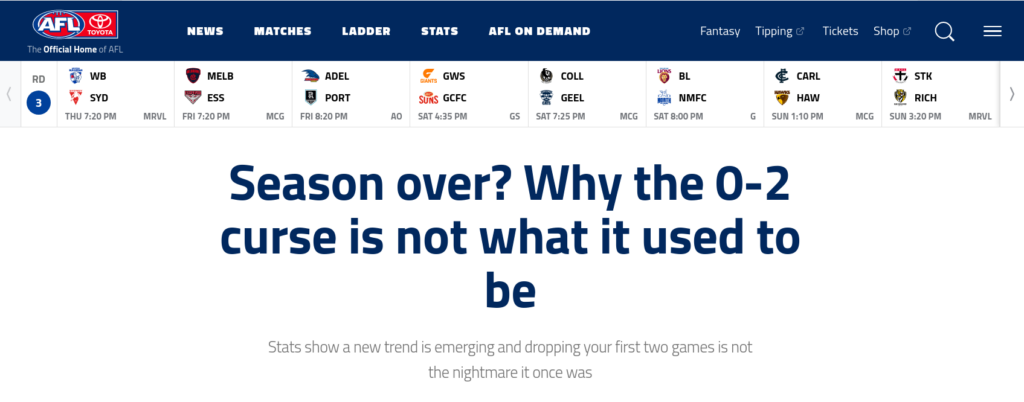I enjoy a useless AFL stat as much as the next person, but this kind of thing tests me:

“Curse” is a bit of a tell in footy. It usually means “coincidence.” If it was a real effect, we’d have a decent theory about why. People love to invent theories. There’s no effect we won’t try to pair with a cause, no matter how thin the evidence. When there’s an effect and no cause, I tend to doubt it’s due to the spooky unseen hand of an unnamed force.
Usually a “curse” is an odd stat that, at first glance, seems like it can’t be the result of random chance, but that’s only because we don’t understand randomness. Our gut tells us that flipping five heads in a row is basically impossible, for example, when in fact true randomness tends to contain a lot more natural variation than people think. (You can flip ten heads in a row, if you’re willing to toss coins for a few hours, and people will think you’re a magician.)
Here’s the 0-2 stat:

I have a few problems with this.
First, I have to point out it’s technically wrong, because we’ve had nine finalists from 0-2, counting Carlton in 2013 who were elevated from ninth after Essendon’s disqualification.
But more importantly, the underlying effect sounds suspiciously like “It’s harder to make finals if you lose games.” And we knew that already. Is there anything magical about the first two games? Because if not, it’s just saying that dropping games hurts your finals chances.
Then there’s two snipes: the starting point (2010), and the number of games (2). If there’s a genuinely interesting effect here, and not a coincidence, we should expect to see not-quite-as-dramatic-but-still-suggestive numbers when those key numbers are varied a little.
Instead, it vanishes pretty abruptly. If you look at a longer time period, you see about 20% of 0-2 teams making finals, and if you look at 0-1 or 0-3 or 0-4 teams, the numbers again are about what you’d expect: about one-third of 0-1 teams make it, about one-in-ten 0-3 teams, and only Sydney 2017 has made it from 0-4 this century. So the more games you lose, the harder it is to make finals, in a steady and predictable way.
Because what actually happened here – the whole reason this stat became popular – is that between 2008 and 2016, there was a patch where only two 0-2 teams made finals (Carlton 2013 and Sydney 2014). This hit rate was quite a bit lower than the years before and after, although not wildly so:
| Year | Finalists from 0-2 |
| 2000 | 2 out of 5 |
| 2001 | 1 out of 5 |
| 2002 | 1 out of 5 |
| 2003 | 1 out of 3 |
| 2004 | 2 out of 4 |
| 2005 | 0 out of 3 |
| 2006 | 2 out of 3 |
| 2007 | 1 out of 4 |
| 2008 | 0 out of 4 |
| 2009 | 0 out of 4 |
| 2010 | 0 out of 6 |
| 2011 | 0 out of 4 |
| 2012 | 0 out of 5 |
| 2013 | 1 out of 7 |
| 2014 | 1 out of 6 |
| 2015 | 0 out of 5 |
| 2016 | 0 out of 4 |
| 2017 | 1 out of 8 |
| 2018 | 1 out of 4 |
| 2019 | 1 out of 5 |
| 2020 | 1 out of 4 |
| 2021 | 3 out of 5 |
Eyeballing that, you might notice something else about the middle years: There are more 0-2 teams. And indeed we had a number of clubs at historical lows in this period, including two teams who were introduced to the league. Fourteen of those 0-2 non-finalists from 2008-2016 are actually just four clubs failing over and over: the two expansion teams plus Melbourne and Richmond.
So this always looked a fair bit like random variation plus an unusually weak bottom end of the comp. But somehow it gave birth to a “curse” that meant flag contenders couldn’t afford to drop their second game.
And now that regular service has resumed – implying that there was never much to see in the first place – “a new trend is emerging.”
